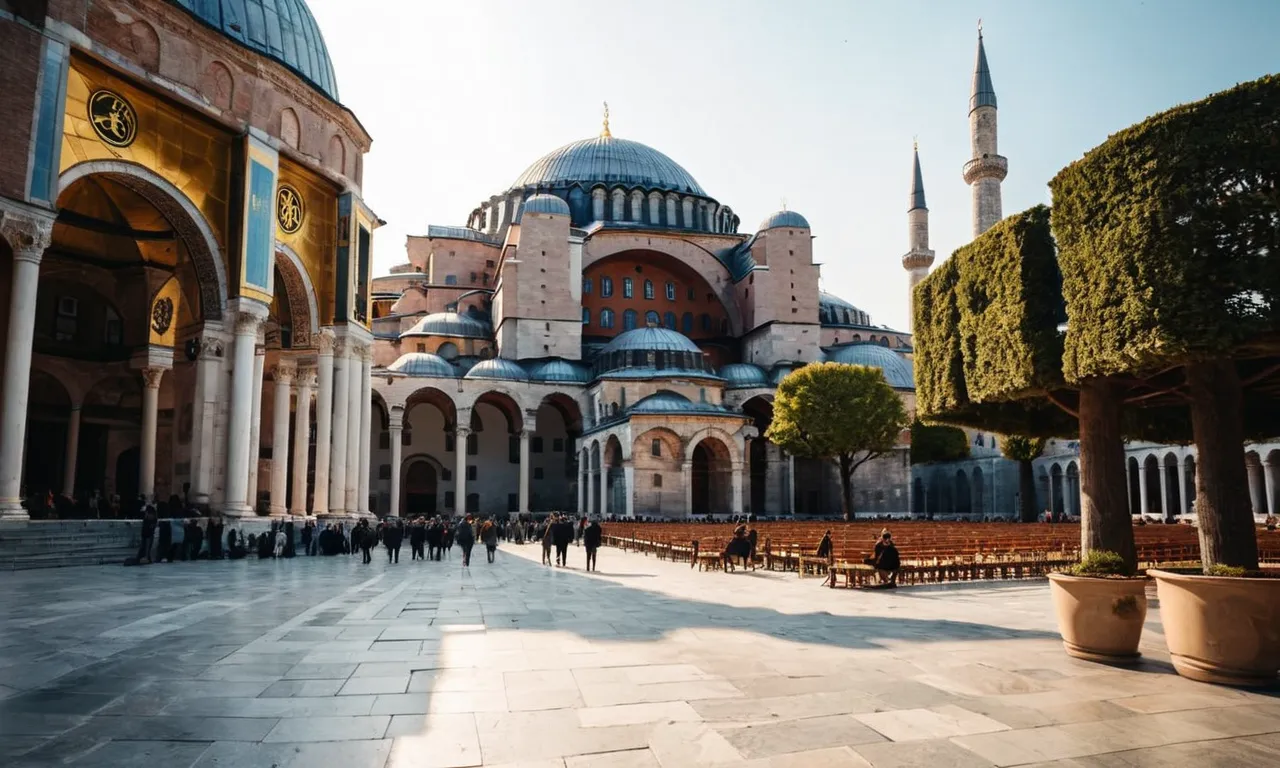Who Moved The Capital Of The Roman Empire From Rome To Byzantium
The Roman Empire spanned over a thousand years, from 27 BC to 1453 AD, and over that time its capital was moved multiple times. But perhaps one of the most impactful moves was when Emperor Constantine the Great decided to establish a new imperial capital at the ancient site of Byzantium in 330 AD.
If you’re short on time, here’s a quick answer: It was Roman Emperor Constantine the Great who made the decision in 330 AD to move the capital from Rome to the ancient city of Byzantium, which he then renamed Constantinople.
In this comprehensive article, we will explore the full story behind this hugely consequential move that led to the establishment of what became known as the Byzantine Empire. We will look at what led Constantine to make this decision, the process of building the new capital city of Constantinople, what impacts the move had at the time and long into the future, and more.
Background – Why Was the Move Made?
Political and Security Reasons
In the early 4th century CE, the Roman Empire was facing increasing threats from invading barbarian tribes, internal political instability, and economic struggles. The Emperor Constantine decided to move the capital from Rome to the ancient city of Byzantium (later renamed Constantinople) for several key reasons:
- Byzantium was located further east, making it harder for barbarian tribes to attack and invade.
- It had natural defenses provided by the sea and hilly terrain around it.
- It was closer to the economically vibrant Eastern territories of the Empire.
- Rome itself held pagan associations that Constantine, the first Christian emperor, wanted to leave behind in favor of a new Christian capital.
In essence, Constantinople would be better protected and support the Emperor’s desire for a new type of imperial domain centered on Christianity.
Strategic Location of Byzantium
The ancient site of Byzantium held an extremely strategic position that lent itself well to being a new imperial capital. Located on the European side of the Bosphorus strait, it essentially straddled Europe and Asia. This conferred several key advantages:
- It could control vital sea trade routes between the Mediterranean and Black Seas.
- Its ports could receive merchant ships from all directions.
- It was located along major east-west land trade routes between Europe and Asia.
- Its position could support naval forces controlling the strait and fighting off seaborne enemies.
In addition, there were already established trade networks, urban infrastructures, and fortifications at Byzantium. As the historian Procopius stated, “…it occupies a convenient position on the seaboard, and is well supplied with all the gifts of fortune.”
The site was ripe for expansion into an imperial capital that could control trade, transport, and security throughout the eastern Mediterranean region.
The Foundation of Constantinople
Site Selection and Expansion
In 324 AD, Emperor Constantine chose the ancient city of Byzantium as the site for his new imperial capital. This strategic location on the European side of the Bosphorus strait provided excellent access to both the Balkans and Anatolia.
Over the next six years, Constantine embarked on an ambitious building program to transform Byzantium into a imperial capital worthy of Rome. The city boundaries were greatly expanded, increasing the enclosed area over fourfold to accommodate exponential population growth in the new capital.
Architectural Design and Construction
Constantinople featured magnificent architectural landmarks constructed under Constantine’s patronage. These included the Great Palace complex, the Hippodrome for chariot racing, several public bathhouses, the Milion mile marker, and over 50 churches, including the famed Hagia Sophia cathedral.
Constantine also commissioned new infrastructure such as aqueducts, cisterns, granaries, and a sewer system capable of supporting over half a million inhabitants at its peak.
Incentives and Growth of the New Capital
To encourage rapid settlement in Constantinople, Constantine instituted policies favorable to both rich elites and poorer citizens. Aristocrats were allowed to purchase prime real estate while grain was distributed to urban residents.
The population swelled as a result, turning Constantinople into a cosmopolitan melting pot. Within a century of its founding by Constantine in 324 AD, Constantinople had become the largest and wealthiest city in the Eastern Mediterranean.
Impacts and Significance
Political and Cultural Influence in Late Antiquity
The relocation of the capital from Rome to Constantinople by Emperor Constantine in 330 AD had profound political and cultural impacts in late antiquity. As the new capital, Constantinople became the preeminent city in the eastern Mediterranean and served as the center of imperial administration, military power, economic prosperity, and religious authority in the region.
Politically, Constantinople was ideally located to defend against threats from the east and control territories in the Balkans. The city grew to rival Rome in population and splendor. Emperors resided in Constantinople, which reduced Rome’s political importance even as the city retained symbolic value.
Culturally, Constantinople sat at the crossroads of Greek, Roman, and eastern influences. It became a melting pot that produced the unique Byzantine civilization. The city boasted imperial monuments, churches, palaces, and outstanding architecture that mixed Roman, Greek, and Near Eastern traditions.
As a Christian capital, Constantinople also held religious significance. Its patron saint was Mary, in contrast to Rome’s Saint Peter. Constantinople became the seat of the Patriarch of the Eastern Orthodox Church which grew apart from the Roman Catholic Papacy centered in Rome.
This contributed to growing east-west religious divides. Overall, the strategic relocation initiated declines for Rome but inaugurated Constantinople’s centuries-long reign as the “Queen of Cities” in the medieval eastern Mediterranean until its fall to the Ottomans in 1453.
The Byzantine Empire and its Enduring Legacy
The eastern Roman Empire based in Constantinople became known as the Byzantine Empire after the west fell. It preserved elements of classical Roman culture while developing a distinct Greek-influenced identity. The Empire lasted until 1453 CE, making it the longest-enduring Roman state.
Its contributions were immense.
The Byzantine Empire acted as a shield protecting Europe from eastern invaders for centuries. It developed a powerful army and navy and ingenious Greek Fire incendiary weapons. Culturally, Byzantine art and architecture inspired medieval Europe with its domed churches, mosaics, and icons.
As a Christian state, Byzantium spread Orthodoxy and converted eastern European peoples. Its missionaries like Cyril and Methodius brought Orthodox Christianity and literacy to the Slavs through translations.
In terms of economy, Constantinople was a wealthy hub of global trade networks linking Europe, Asia, and Africa. It had a robust monetary economy and complex taxation system unknown in western Europe for centuries after Rome’s fall.
Technologically, the Byzantines retained Roman expertise in road building, architecture, and water systems like aqueducts and cisterns. They also developed their own influential defenses like the massive Theodosian Walls shielding Constantinople.
The Byzantine Empire’s longevity and resilience against centuries of threats attests to its intelligent political and military leadership. As the continuation of the Roman Empire in the east, Byzantium provided a vital bulwark that transmitted classical Greco-Roman culture and Christian religion into the medieval era.
Its impact shaped the progress of modern Europe, Middle East, and Russia up to the present day.
Conclusion
In the end, Constantine’s decision to move the capital of the Roman Empire from Rome to the site of Byzantium and establish Constantinople proved to be hugely significant both at the time and for centuries to come.
It marked the beginning of major political and cultural transformations, facilitated the spread of Christianity in the Eastern Mediterranean region, and laid the foundations for the Byzantine Empire which carried on the legal and cultural traditions of Rome long after the Western Empire fell.
While Constantinople would itself eventually fall, it served for over a thousand years as a major global center of power, religion, and trade – a lasting testament to the ambitious vision and foresight of Constantine the Great.








